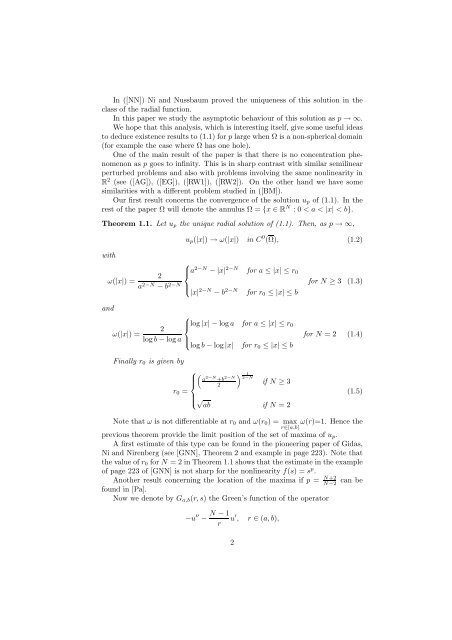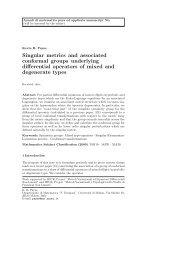Asymptotic behaviour of the Kazdan-Warner solution in the annulus ∗
Asymptotic behaviour of the Kazdan-Warner solution in the annulus ∗
Asymptotic behaviour of the Kazdan-Warner solution in the annulus ∗
Create successful ePaper yourself
Turn your PDF publications into a flip-book with our unique Google optimized e-Paper software.
In ([NN]) Ni and Nussbaum proved <strong>the</strong> uniqueness <strong>of</strong> this <strong>solution</strong> <strong>in</strong> <strong>the</strong><br />
class <strong>of</strong> <strong>the</strong> radial function.<br />
In this paper we study <strong>the</strong> asymptotic <strong>behaviour</strong> <strong>of</strong> this <strong>solution</strong> as p → ∞.<br />
We hope that this analysis, which is <strong>in</strong>terest<strong>in</strong>g itself, give some useful ideas<br />
to deduce existence results to (1.1) for p large when Ω is a non-spherical doma<strong>in</strong><br />
(for example <strong>the</strong> case where Ω has one hole).<br />
One <strong>of</strong> <strong>the</strong> ma<strong>in</strong> result <strong>of</strong> <strong>the</strong> paper is that <strong>the</strong>re is no concentration phenomenon<br />
as p goes to <strong>in</strong>f<strong>in</strong>ity. This is <strong>in</strong> sharp contrast with similar semil<strong>in</strong>ear<br />
perturbed problems and also with problems <strong>in</strong>volv<strong>in</strong>g <strong>the</strong> same nonl<strong>in</strong>earity <strong>in</strong><br />
R 2 (see ([AG]), ([EG]), ([RW1]), ([RW2]). On <strong>the</strong> o<strong>the</strong>r hand we have some<br />
similarities with a different problem studied <strong>in</strong> ([BM]).<br />
Our first result concerns <strong>the</strong> convergence <strong>of</strong> <strong>the</strong> <strong>solution</strong> up <strong>of</strong> (1.1). In <strong>the</strong><br />
rest <strong>of</strong> <strong>the</strong> paper Ω will denote <strong>the</strong> <strong>annulus</strong> Ω = {x ∈ R N : 0 < a < |x| < b}.<br />
Theorem 1.1. Let up <strong>the</strong> unique radial <strong>solution</strong> <strong>of</strong> (1.1). Then, as p → ∞,<br />
with<br />
ω(|x|) =<br />
2<br />
a 2−N − b 2−N<br />
up(|x|) → ω(|x|) <strong>in</strong> C 0 (Ω), (1.2)<br />
⎧<br />
⎪⎨ a2−N − |x| 2−N for a ≤ |x| ≤ r0<br />
⎪⎩<br />
|x| 2−N − b2−N for r0 ≤ |x| ≤ b<br />
and<br />
⎧<br />
⎪⎨ log |x| − log a for a ≤ |x| ≤ r0<br />
2<br />
ω(|x|) =<br />
log b − log a ⎪⎩<br />
log b − log |x| for r0 ≤ |x| ≤ b<br />
F<strong>in</strong>ally r0 is given by<br />
⎧<br />
1<br />
2−N 2−N 2−N<br />
⎪⎨<br />
a +b<br />
2 if N ≥ 3<br />
r0 =<br />
⎪⎩ √<br />
ab if N = 2<br />
for N ≥ 3 (1.3)<br />
for N = 2 (1.4)<br />
(1.5)<br />
Note that ω is not differentiable at r0 and ω(r0) = max ω(r)=1. Hence <strong>the</strong><br />
r∈[a,b]<br />
previous <strong>the</strong>orem provide <strong>the</strong> limit position <strong>of</strong> <strong>the</strong> set <strong>of</strong> maxima <strong>of</strong> up.<br />
A first estimate <strong>of</strong> this type can be found <strong>in</strong> <strong>the</strong> pioneer<strong>in</strong>g paper <strong>of</strong> Gidas,<br />
Ni and Nirenberg (see [GNN], Theorem 2 and example <strong>in</strong> page 223). Note that<br />
<strong>the</strong> value <strong>of</strong> r0 for N = 2 <strong>in</strong> Theorem 1.1 shows that <strong>the</strong> estimate <strong>in</strong> <strong>the</strong> example<br />
<strong>of</strong> page 223 <strong>of</strong> [GNN] is not sharp for <strong>the</strong> nonl<strong>in</strong>earity f(s) = sp .<br />
Ano<strong>the</strong>r result concern<strong>in</strong>g <strong>the</strong> location <strong>of</strong> <strong>the</strong> maxima if p = N+2<br />
found <strong>in</strong> [Pa].<br />
Now we denote by Ga,b(r, s) <strong>the</strong> Green’s function <strong>of</strong> <strong>the</strong> operator<br />
−u ′′ −<br />
N − 1<br />
u<br />
r<br />
′ , r ∈ (a, b),<br />
2<br />
N−2<br />
can be








